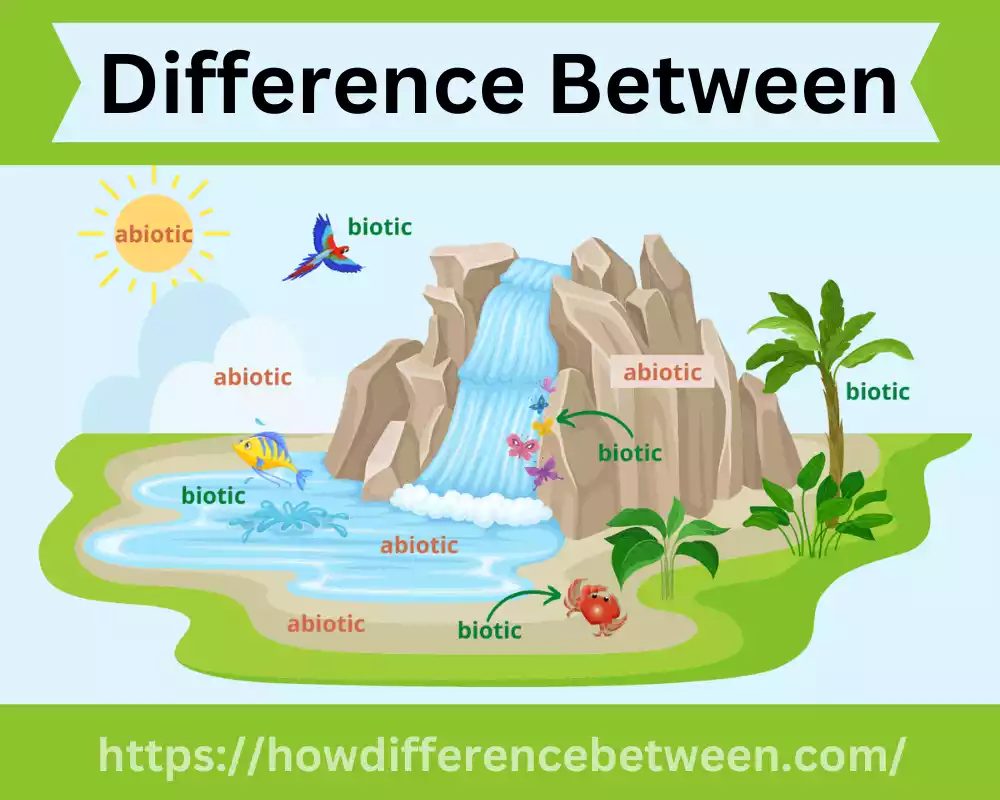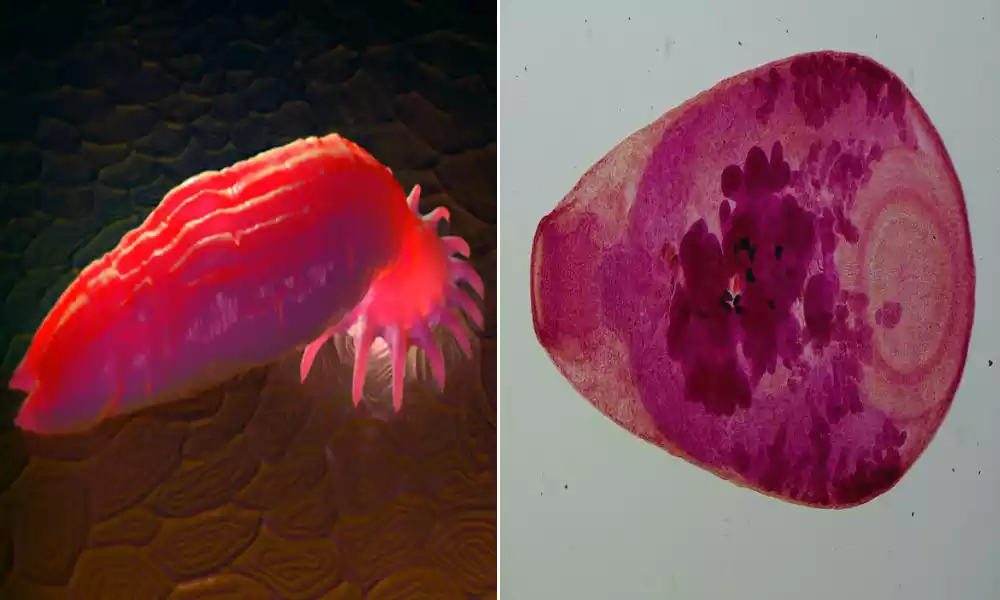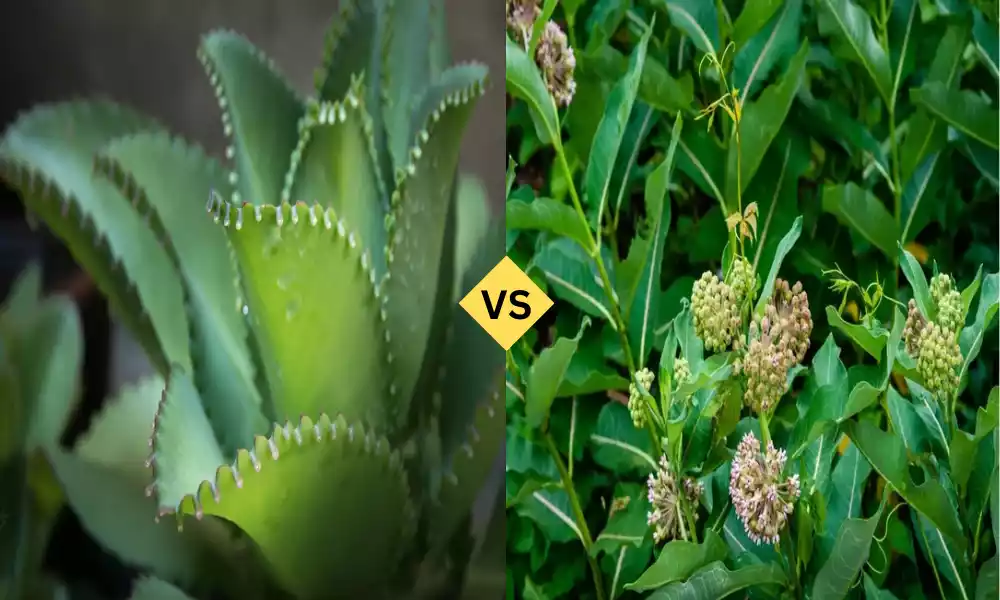Biotic and Abiotic
Biotic factors in an Ecosystem refer to all living components which interact, including plants, animals, fungi, bacteria, and microorganisms that interact. Together these biotic factors play an integral part in energy flow, nutrient cycling, and population dynamics within an ecosystem.
Abiotic factors refers to all non-living components in an ecosystem – typically physical or chemical elements like temperature, sunlight, water quality and composition, air quality as well as geological features – which influence organism survival, distribution, and behavior within an ecosystem as well as overall structure and functioning of an ecosystem.
Importance of understanding the difference between Biotic and Abiotic
- Ecosystem Understanding: Recognizing and distinguishing between biotic and abiotic factors provides us with a foundation for comprehending all the components and processes that shape an ecosystem, including interactions among living organisms as well as any influences from nonliving surroundings. This allows us to discern interactions, dependencies, and influences among them all in relation to one another.
- Ecological Research: Studying interactions between biotic and abiotic factors is central to ecological research, helping scientists investigate the impacts of environmental changes on species distribution, population dynamics, and ecosystem functioning. By comprehending such elements of an ecosystem’s resilience, vulnerability, and adaptability.
- Conservation and Management: Successful conservation and management of ecosystems requires understanding both biotic and abiotic factors. With respect to organisms, knowing their needs and requirements helps in crafting appropriate conservation strategies and recognizing how abiotic factors such as habitat degradation or climate change could pose threats that must be managed appropriately with mitigation plans in place to adapt accordingly.
- Predicting and Responding to Environmental Changes: Changes to both biotic and abiotic factors have profound effects on ecosystem stability and function, thus making the knowledge essential for anticipating environmental shifts and creating strategies to adapt. Understanding their differences allows us to predict their effects, assess them on ecosystems and their inhabitants as well as make informed decisions to adapt or mitigate such environmental modifications.
- Education and Awareness: Differentiating biotic from abiotic factors is central to ecological education, helping individuals gain a holistic view of ecosystems and their complex interdependences. Teaching this distinction promotes environmental awareness while inspiring responsible actions for conserving natural resources.
Definition of Biotic
Biotic refers to all living organisms within an ecosystem and their interactions. This term includes all living components ranging from microorganisms, plants, and animals through microbes to fungi and bacteria. Biotics play key roles in shaping ecosystem structure, functioning, and dynamics through various ecological processes like energy flow, nutrient cycling reproduction predation competition symbiosis.
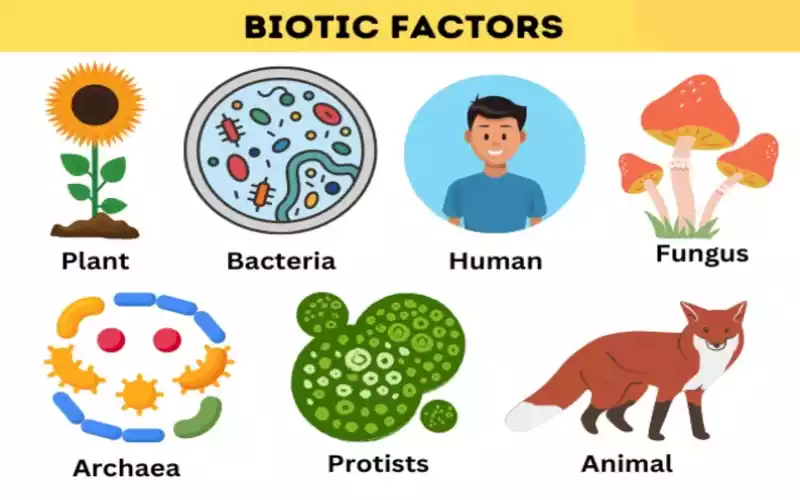
Biotic factors are defined as organisms capable of reproducing, growing, and responding to environmental stimuli in an unpredictable world. With numerous adaptations and behaviors designed to ensure they thrive within their respective habitats. Their complex network interactions create intricate ecological communities or food webs.
Producers (also referred to as autotrophs) play an essential part in biota. Capable of synthesizing their food via photosynthesis or chemosynthesis – using energy from sunlight or inorganic compounds into organic matter for consumption by consumers – producers form the cornerstones of food chains by providing nourishment for them.
Consumers (or heterotrophs) are organisms that obtain energy by eating other organisms; their survival relies on organic matter produced by producers as it feeds directly to them through producers’ bodies and waste streams. Consumers may be divided into various feeding habits classifications including herbivores, carnivores, omnivores, and decomposers.
Interactions among biotic factors are crucial in maintaining ecosystem stability and functionality, whether cooperative, competitive, or exploitative in nature. Examples of interactions include mutualistic relationships where both organisms benefit; predation where one organism feeds upon another organism; or competition over scarce resources.
Biotic Role in Ecosystems
- Producers: Producing Organisms also referred to as autotrophs, are those organisms capable of creating their own food through photosynthesis or chemical chemosynthesis. As producers form the backbone of any food chain by converting solar or chemical energy into organic matter – such as plants, algae, or bacteria – producers provide energy and nutrition for other organisms in an ecosystem.
- Consumers: Consumers (or heterotrophs) are organisms that obtain energy by feeding on other organisms for sustenance. Consumers rely on organic matter produced by producers for survival; consumers may include herbivores (plant eaters), carnivores (meat eaters), omnivores (eat both plants and animals) or decomposers (break down dead organic matter), providing energy and nutrients up the food chain.
- Decomposers: Bacteria and fungi serve as decomposers to break down dead organic matter and waste materials, recycling nutrients back into the ecosystem and aiding with decomposition processes. Decomposers play an essential role in recycling nutrients back into nature through the recycling of complex organic molecules into more digestible forms that are easily absorbed and utilized by producers as part of the decomposition process.
- Predator-Prey Interactions: Predators consume other organisms (prey) for energy and nutrients, creating interactions that regulate population sizes and maintain balance within an ecosystem. Predation helps control herbivore populations to prevent overgrazing while simultaneously encouraging plant diversity; it also influences prey behavior to adapt for defense and survival purposes.
- Symbiotic Relationships: Symbiotic relationships involve close and long-term interactions among various species. Examples include Mutualism, where both parties benefit, commensalism, where only one party benefits while the other remains unaffected; and parasitism where only one species gains by exploiting another one’s resources at their expense. Such partnerships contribute to species coexistence, nutrient exchange, and ecosystem stability – essential elements in maintaining ecological sustainability.
- Ecosystem Engineers: Certain organisms such as beavers, termites, and coral reef-building organisms act as ecosystem engineers by altering their habitats to increase resource availability while creating niches for other organisms. Their engineering activities may have significant effects on ecosystem structure, hydrology, and biodiversity.
Definition of Abiotic
Abiotic refers to all nonliving components or factors in an ecosystem that do not belong to living beings, including physical and chemical aspects that shape it and impact ecosystem functioning. Abiotic factors arise through physical and chemical processes without possessing biological characteristics that give life its identity.
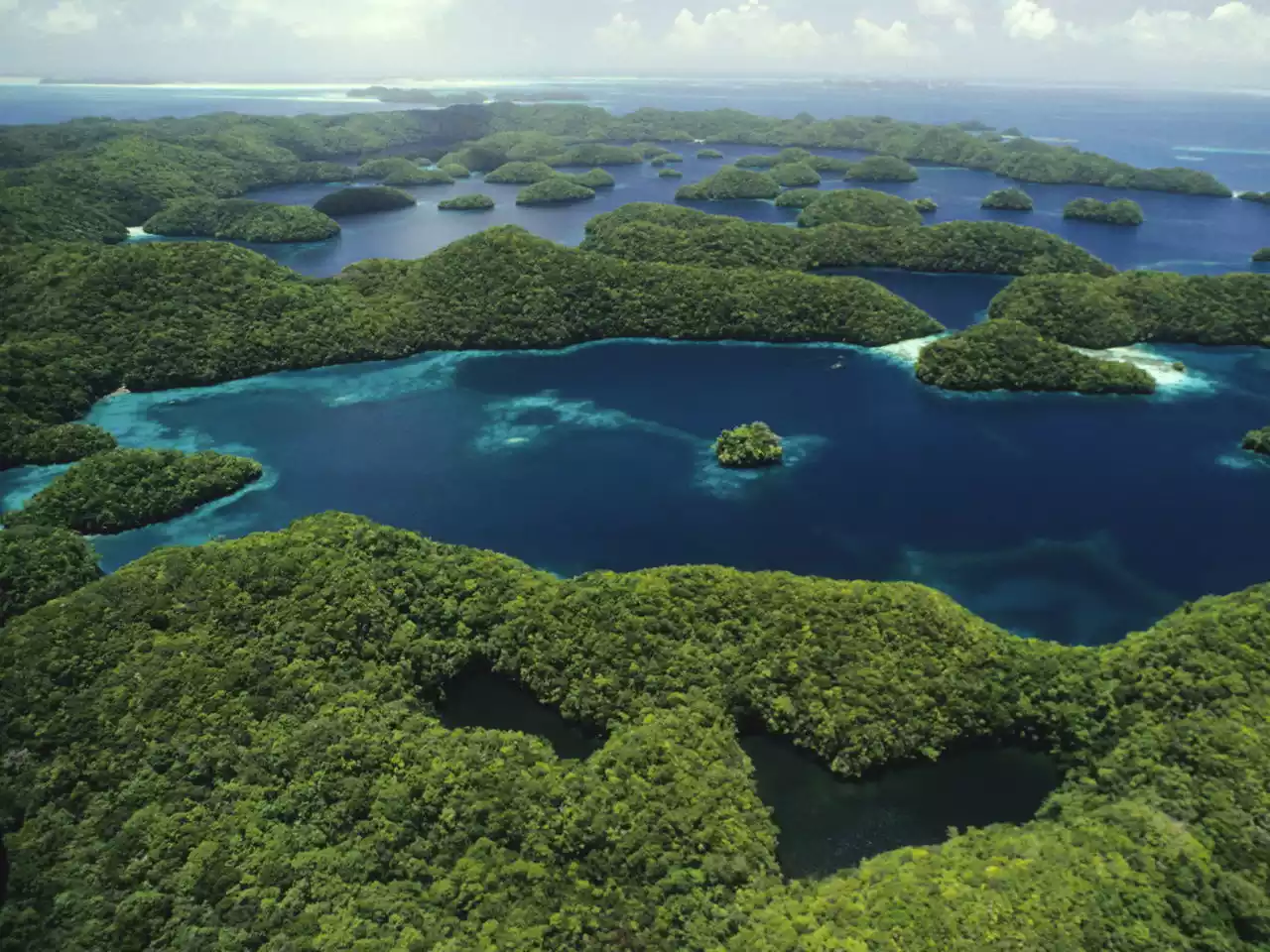
Abiotic factors include many elements and conditions, including temperature, sunlight, water availability, soil composition, air quality, precipitation rates, humidity levels, wind patterns, and geological features that influence organism distribution, abundance, and survival within ecosystems. All these variables play a part in shaping organism populations within an ecosystem.
Temperature changes affect metabolic rates and physiological functions in organisms; sunlight availability affects photosynthesis in plants as well as animal behavior and activity patterns, and water availability and quality is an integral components for survival and growth affecting habitat suitability and aquatic ecosystem functioning; soil composition influences nutrient availability which ultimately decides what types of plants can grow in an area; while air quality impacts respiratory systems directly.
Abiotic factors interact with each other and with biological components to shape ecosystem processes and dynamics, with changes to any of them have far-reaching ramifications on ecosystem processes and dynamics. Alterations to any one or more abiotic factors, however, can have devastating repercussions for their structure or functioning – temperature shifts could disrupt flowering cycles or migration times, while precipitation patterns altering could alter water resources availability while altering species distributions.
Abiotic Role in Ecosystems
Climate and Weather: Abiotic factors like temperature, sunlight exposure, precipitation levels, and wind patterns all have an immense effect on ecosystem climate and weather conditions. This has an enormous influence on organism distribution and behavior; various species require certain temperatures or moisture conditions in order to thrive; changes to their surroundings may alter survival, reproduction, and overall ecosystem dynamics.
- Water Availability: Water availability is a vital abiotic factor that determines ecosystem structure and function. It impacts species distribution, habitat types that support life, ecosystem productivity, and plant growth; as well as impacts such as drought or excessive rainfall that have devastating consequences on its structure and function.
- Soil Characteristics: Soil composition, texture, and fertility are three abiotic factors that have an enormous effect on which plants can flourish in an ecosystem. Different species have individual requirements for nutrients, pH levels, and drainage. Soil characteristics also impact microbial communities as well as decomposition rates affecting ecosystem processes and nutrient cycling rates, impacting both processes as well as decomposition rates affecting decomposition rates within an ecosystem.
- Topography and Geology: Physical features such as mountains, valleys, and soil composition play an essential role in ecosystem structure and function. Topography influences water drainage patterns which in turn influence habitat creation as well as plant distribution patterns; geology plays an integral part in soil formation, mineral availability, and aquatic ecosystem composition.
- Light Availability: Light is a key abiotic factor for photosynthesis and it impacts plant growth and development in different ways depending on species requirements ranging from shade-tolerant species to those needing full sun. Light also affects behavior, reproduction, and ecological interactions such as diurnal/nocturnal activity patterns and camouflage strategies of organisms.
- Air Quality and Atmospheric Composition: Air quality and composition play an integral part in maintaining human and animal health and survival. Pollutants such as particulate matter and chemicals have adverse impacts on plants and animals alike, while changes to atmospheric composition – such as increasing carbon dioxide levels – may impede photosynthesis, carbon cycling, and photosynthesis processes.
Comparison table of Biotic and Abiotic
Here’s a comparison chart highlighting the differences between biotic and abiotic factors:
| Biotic Factors | Abiotic Factors |
|---|---|
| Living organisms | Non-living components |
| Originates from biological processes | Originates from physical and chemical processes |
| Reproduce, grow, and respond to stimuli | Do not possess characteristics of life |
| Dependent on other organisms for existence | Exist and function independently of organisms |
| Examples: plants, animals, microorganisms | Examples: temperature, sunlight, water availability, soil composition |
| Involved in energy flow, nutrient cycling, and ecological interactions | Influence the distribution, abundance, and behavior of organisms |
| Interact with each other through predation, competition, and symbiosis | Interact with biotic factors, shaping ecosystem characteristics |
| Play vital roles in ecosystem structure, functioning, and dynamics | Impact ecosystem processes and provide physical and chemical conditions for life |
| Studied to understand population dynamics, species interactions, and biodiversity | Studied to assess environmental conditions, predict impacts, and manage ecosystems |
Examples of Biotic and Abiotic Interactions
Examples of biotic and abiotic interactions within an ecosystem include:
- Biotic Interaction: Predation
Example of Biotic Interaction: Predator Consuming Prey. This interaction influences both species populations, shaping their distribution throughout an ecosystem and ultimately changing its dynamics. .
- Biotic Interaction: Mutualism
Example: Flowering plants interact with pollinators like bees or birds by providing nectar as food, while pollinators transport pollen between flowers for reproduction of those flowers.
- Biotic Interaction: Competition
Example: Two bird species compete for nesting sites and food resources that could result in resource partitioning – where each species adjusts its habitat use or feeding strategies accordingly to reduce direct competition between themselves.
- Abiotic Interaction: Temperature and Species Distribution
Example: Certain plant species have evolved to thrive at specific temperature ranges. As climate conditions alter, their distribution changes accordingly and some species flourish while others decline, with new areas taking hold as others shift out of favor.
- Abiotic Interaction: Temperature and Species Distribution
Example: Plant growth and survival depend heavily upon water availability; in areas with limited resources, certain plant species have developed adaptations like deep root systems in order to access deeper layers for moisture access.
- Biotic and Abiotic Interaction: Soil Fertility and Plant Nutrition
Example: Soil composition (abiotic) plays a significant role in plant nutrition availability. Decomposers such as fungi and bacteria (biotic), break down organic matter into nutrients for release into the soil, enriching it while providing essential nutrient source for plant development.
These examples demonstrate the dynamic interplay of biotic and abiotic factors within ecosystems, where living organisms influence population dynamics, resource utilization, reproduction, distribution and physiological function – ultimately shaping ecosystem structure, functioning and stability.
Summary
Both Biotic and Abiotic factors interact with each other and shape the structure, functioning, and stability of ecosystems. Changes in these factors can have significant impacts on ecosystem health, biodiversity, and the services they provide. Therefore, studying and managing these factors are essential for effective conservation, sustainable resource management, and understanding the intricate relationships within ecosystems.

